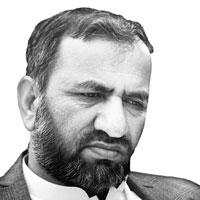KABUL — Fierce fighting reportedly broke out over the weekend between rival Taliban groups, raising concerns that no faction will be strong enough to make a peace deal, even if it were inclined to do so, and possibly opening the way to more recruitment by the growing forces in Afghanistan of the so-called Islamic State.
While the United States and the Kabul government previously sought to “divide and conquer” the group, under the current circumstances in Afghanistan, this latest development may only heighten the fracturing of society and the chaos of war.
Throughout most of the two decades the group has existed, under the leadership of the one-eyed Mullah Omar the Taliban showed remarkable unity. They took power in the mid-1990s, then were ousted by the American-led invasion in 2001 for protecting Osama bin Laden, and in the years since they’ve struggled to retake the government—but, still, they stuck together.
Almost as soon as the death of Mullah Omar was confirmed last July—and revealed to have taken place two years earlier—the cracks began to show.
Mullah Akhtar Muhammad Mansoor stepped forward to present himself as the anointed successor and “Leader of the Faithful.” But several senior Taliban figures announced their opposition, including: the ex- governor of Kandahar, Mullah Hasan Rahmani; the Taliban interior minister, Mullah Abdul Razak Akhond, another ex-governor, Mullah Abdul Manan Niazi; and Mullah Muhammad Rasool Akhond, widely known as Mullah Rasool.
By August, some of Mansoor’s opponents began blaming Mansoor for the mysterious death of their former supreme leader. Mansoor then branded them traitors. He eventually persuaded a few to quit the opposition, and he appeared to be energizing the Taliban ranks when he managed to seize the major city of Kunduz, in the north, in September, and hold it for several days against a ferocious government counterattack backed by U.S. warplanes.
But last Wednesday senior members of the splinter group announced they would follow Rasool as the new leader.
In his first speech, Rasool blamed Mansoor for killing and kidnapping Taliban comrades, and for making secret contacts with Americans. And on Sunday, fighting broke out in Zabul province, an area with a heavy Taliban presence between Kandahar and the Pakistan border, with at least 10 reported killed among Mansoor’s ranks and 40 among Rasool’s.
Kabul’s representative in the province, Governor Anwar Isahqzai, told Al Jazeera that Rasool’s people were backed up by Uzbek fighters and ISIS, which has had a growing presence in the country over the last year, but a spokesman for the Rasool group denied this.
An ex-Afghan Taliban minister told The Daily Beast that, given the tribal nature of Afghan society, defections in Afghan politics are common practice. The mujahideen who fought together to oust the Soviets in the 1980s quickly split into seven factions, but the Taliban remained united for two decades.
“The United States, Afghan intelligence and other westerners personally contacted us for defection and we rejected them,” said the ex-minister. “Now it’s unfortunate for the Taliban that a whole group of respected names have split.” The ex-minister says he supports Mansoor, but is increasingly concerned about internecine warfare. “I am worried at the end one group of Taliban will be beheading another group of Taiban and that would be a disastrous scenario for Islam and the Taliban.”
Mullah Rasool and one of his deputies, Mullah Mansor Dadullah, belong to the Noorzia and Kakar tribes and have gotten broad support, as well as some fighters, from them.
Mullah Mansor Dadullah is the brother of the Mullah Dadullah who commanded Taliban troops before and after the 2001 invasion, suppressing the Hazaras, and blowing up the Buddhas of Bamiyan, then leading the insurgency against the U.S.-backed government until he was killed by U.S. and British special forces in 2007. Mamsor Dadully has now been appointed as military commander of the splinter group.
Taliban sources said late last week, before the fighting erupted, that Mullah Mansoor ordered his fellow commanders to dismiss and disarm Dadullah in Zabul province.
Multiple Western sources in Kabul and Islamabad told The Daily Beast that they are not thrilled about any split emerging among the Afghan Taliban.
“We believe now it would not be possible to totally dismantle the Afghan Taliban,” said one Western diplomat. “Thus the only possible solution for the Afghan conflict is peace and reconciliation,” and for that, “united Taliban are better than Taliban divided in groups.”
The diplomat said that if the Taliban continue to splinter, members will be vulnerable to international terrorist groups, notably ISIS and al Qaeda. “For survival these group would not mind getting support from any terrorist group,” he said. “That would not be an ideal scenario.”
In fact there may soon be three contending groups. Another senior Afghan Taliban leader today told The Daily Beast on Tuesday three important figures—ex-military chief Abdul Qayum Zakir , ex-Interior Minister Mullah Abdul Razak, and Hasan Rahmani, who was very close to Mullah Omar—have not pledged support to Mansoor or Rasool.
Barnett Rubin of the Center on International Cooperation in New York told The Daily Beast “splits are not helpful to the peace process if they give gross incentive to compete by being more militant.”





